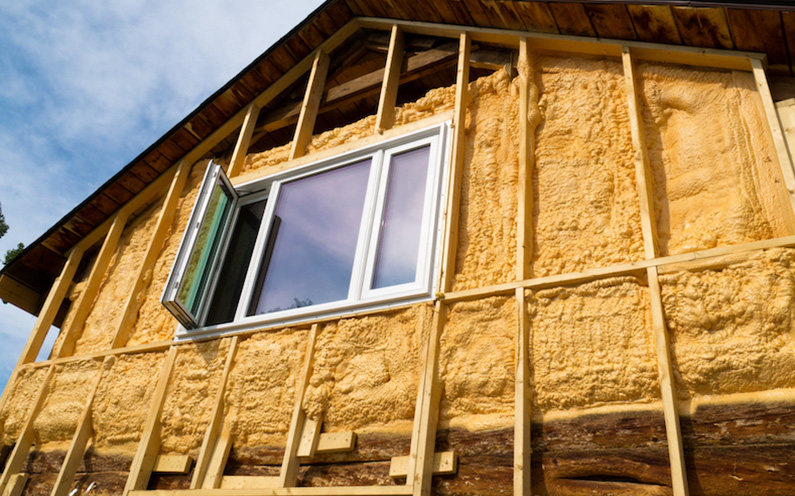
- Fiberglass insulation is made up of small little glass fibers that are spun together and can come in a blanket style of loose-fill style.
- Spray foam insulation is made up of recycled plastic that is blown-in to attic spaces & can fill the smallest of crevasses.
- Spray foam is preferred to fiberglass as spray foam insulation is more water resistant, provides a better R value, and lasts longer.
The home building process includes site preparation, framing, plumbing, electrical, HVAC, and at the core, insulation. Although this might seem like a complex process, each of the steps are necessary for any stable home/building. What sets homes and buildings apart among many things, the materials used included. Here at Eagle Insulation, we want your business as much as the next insulation company, but we also want to be completely transparent about our spray foam insulation and how it compares to other, more common types of insulation. Make sure to read to the end of the blog to find our services, location, contact information, and how you can get your free estimate on your insulation contracting job!
Fiberglass Insulation
Fiberglass insulation is made up of just that: glass. Technically, they’re really fine strands of glass that have been spun together like cotton candy. Below we have listed the two types of fiberglass insulation. Fiberglass is fairly easy to install yourself, but it is always recommended that if you have any doubts (and don’t want to get all itchy), hire a professional insulation company. Fiberglass insulation can be found at your typical home-improvement store like Lowes or Home Depot.
Batt fiberglass
Batt style fiberglass insulation is like a blanket, being able to come in whatever size you cut it to be. The little glass pieces stick together because of how it was made: in a spinner that spins molten glass, that’s then smashed together on a conveyor belt. Once it becomes thick enough, it gets stuffed into the wall cavity, filling in as much space as it can.
Loose-Fill Fiberglass insulation
Loose-fill fiberglass insulation is pillow-stuffing pieces that gets blown into the wall cavity after it has been covered with a mesh protective fabric. Unlike batt fiberglass, loose-fill fiberglass is still made up of small glass strands, but they are not spun or smashed together. This type of insulation is specifically to fill odd and unusually shaped spaces, or to fill behind a wall that’s too expensive to tear down.
Spray Foam Insulation
There are a couple main key points that set spray foam insulation apart from fiberglass insulation. One, spray foam insulation has a higher R-value, and if you’ll remember, the higher the R value, the better insulator it is. Two, fiberglass insulation is not waterproof and cracks under high moisture. Spray water is watertight, protecting your home from any unexpected leaks. Some other benefits of spray foam insulation are its flexibility to match architectural features; reduces allergens that would otherwise slip through the small cracks and crevices that fiberglass couldn’t fill; prevents bugs and small rodents from getting into your home or business. There are two main types of spray foam insulation: open cell and closed cell.
Open Cell Spray Foam
- Economical
- Reduces high frequency noises
- Block out the majority of noises
Closed Cell Spray Foam
- Dense
- Keeps water and air out most effectively
- Best for metal buildings and moist environments
Fiberglass Insulation vs Spray Foam Insulation
The things you should consider when choosing an insulation are the level of installation difficulty, if it’s moisture resistant, durability, R-Value, and cost-effectiveness. Now that you have seen both perspectives of insulation, you are able to see that each type of insulation has its pros and cons. However, in the end, spray foam insulation is more energy efficient, more effective against weather elements including unexpected leaks, and is even flexible to architectural designs. There is, however, the fact that fiberglass insulation is typically more affordable for people who are looking for a quick fix, but keep in mind that although spray foam insulation is a little more expensive in the beginning, it is a money saver in the long run.
Eagle Insulation Company
Eagle Insulation was built entirely on the NEED for spray foam. Our goal is to create safer, more environmentally friendly, and properly insulated houses and commercial buildings, which with the direct comparison we provided above, is clear that spray foam is safe. Like we mentioned at the beginning, the benefits of spray foam insulation have been on the back burner of people’s minds for far too long. Let us help you make this new and better change to create an overall healthier community. You’re able to get your free estimate on our website! Give us a call, send us an email, or stop by in person to talk about the next steps in this life improvement.
Phone
Address
Recent Comments